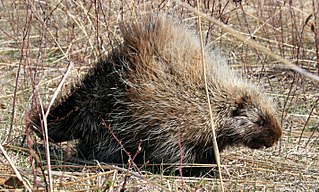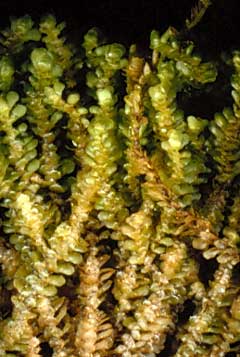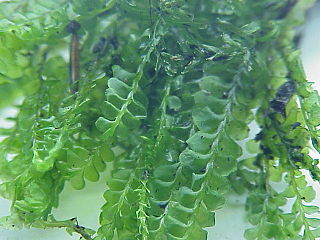
Asterales is an order of dicotyledonous flowering plants that includes the large family Asteraceae known for composite flowers made of florets, and ten families related to the Asteraceae. While asterids in general are characterized by fused petals, composite flowers consisting of many florets create the false appearance of separate petals.

The Brassicales are an order of flowering plants, belonging to the eurosids II group of dicotyledons under the APG II system. One character common to many members of the order is the production of glucosinolate compounds. Most systems of classification have included this order, although sometimes under the name Capparales.

A language family is a group of languages related through descent from a common ancestral language or parental language, called the proto-language of that family. The term "family" reflects the tree model of language origination in historical linguistics, which makes use of a metaphor comparing languages to people in a biological family tree, or in a subsequent modification, to species in a phylogenetic tree of evolutionary taxonomy. Linguists therefore describe the daughter languages within a language family as being genetically related. The divergence of a proto-language into daughter languages typically occurs through geographical separation, with different regional dialects of the proto-language spoken by different speech communities undergoing different language changes and thus becoming distinct languages from each other.

Porcupines are large rodents with coats of sharp spines, or quills, that protect them against predation. The term covers two families of animals: the Old World porcupines of the family Hystricidae, and the New World porcupines of the family Erethizontidae. Both families belong to the infraorder Hystricognathi within the profoundly diverse order Rodentia and display superficially similar coats of rigid or semi-rigid quills, which are modified hairs composed of keratin. Despite this, the two groups are distinct from one another and are not closely related to each other within the Hystricognathi. The largest species of porcupine is the third-largest living rodent in the world, after the capybara and beaver.
Family is one of the eight major hierarchical taxonomic ranks in Linnaean taxonomy. It is classified between order and genus. A family may be divided into subfamilies, which are intermediate ranks between the ranks of family and genus. The official family names are Latin in origin; however, popular names are often used: for example, walnut trees and hickory trees belong to the family Juglandaceae, but that family is commonly referred to as the "walnut family".

The family Scarabaeidae, as currently defined, consists of over 35,000 species of beetles worldwide; they are often called scarabs or scarab beetles. The classification of this family has undergone significant change in recent years. Several subfamilies have been elevated to family rank, and some reduced to lower ranks. The subfamilies listed in this article are in accordance with those in Catalog of Life (2023).

Weevils are beetles belonging to the superfamily Curculionoidea, known for their elongated snouts. They are usually small – less than 6 mm in length – and herbivorous. Approximately 97,000 species of weevils are known. They belong to several families, with most of them in the family Curculionidae. It also includes bark beetles, which while morphologically dissimilar to other weevils in lacking the distinctive snout, is a subfamily of Curculionidae. Some other beetles, although not closely related, bear the name "weevil", such as the biscuit weevil, which belongs to the family Ptinidae.

Haplorhini, the haplorhines or the "dry-nosed" primates, is a suborder of primates containing the tarsiers and the simians, as sister of the Strepsirrhini ("moist-nosed"). The name is sometimes spelled Haplorrhini. The simians include catarrhines, and the platyrrhines.

The Chrysomeloidea are an enormous superfamily of beetles, with tens of thousands of species. The largest families are Cerambycidae, long-horned beetles, with more than 35,000 species, and Chrysomelidae, leaf beetles, with more than 13,000 species.

A cousin is a relative that is the child of a parent's sibling, this is more specifically referred to as a first cousin.

The Batrachomorpha are a clade containing recent and extinct amphibians that are more closely related to modern amphibians than they are to mammals and reptiles. According to many analyses they include the extinct Temnospondyli; some show that they include the Lepospondyli instead. The name traditionally indicated a more limited group.

Jungermanniales is the largest order of liverworts. They are distinctive among the liverworts for having thin leaf-like flaps on either side of the stem. Most other liverworts are thalloid, with no leaves. Due to their dorsiventral organization and scale-like, overlapping leaves, the Jungermanniales are sometimes called "scale-mosses".

Plagiochila deltoidea is a species of liverwort in the family Plagiochilaceae. It was first described by Lindenb. It is found in New Zealand and Tasmania. It resides on wet ground. It can grow to lengths of up to 60 mm with 3 mm wide leaves.

Plagiochila is a large, common, and widespread genus of liverworts in the order Jungermanniales. It is a member of the family Plagiochilaceae within that order. There may be anywhere from 500 to 1300 species, most of them from the tropics; the exact number is still under revision. The genus also has a wide distribution in temperate and arctic areas.
Plagiochila wolframii is a species of plant in the family Plagiochilaceae. It is endemic to Peru. Its natural habitat is subtropical or tropical moist lowland forests. It is threatened by habitat loss.

The Erebidae are a family of moths in the superfamily Noctuoidea. The family is among the largest families of moths by species count and contains a wide variety of well-known macromoth groups. The family includes the underwings (Catocala); litter moths (Herminiinae); tiger, lichen, and wasp moths (Arctiinae); tussock moths (Lymantriinae), including the arctic woolly bear moth ; piercing moths ; micronoctuoid moths (Micronoctuini); snout moths (Hypeninae); and zales, though many of these common names can also refer to moths outside the Erebidae. Some of the erebid moths are called owlets.

William Campbell Steere (1907–1989) was an American botanist known as an expert on bryophytes, especially arctic and tropical American species. The standard author abbreviation Steere is used to indicate this person as the author when citing a botanical name.

Plagiochila fasciculata is a species of liverwort in the family Plagiochilaceae. Found in eastern Australia and New Zealand in moist sites.
Wilfred "Wilf" Borden Schofield was a Canadian botanist, specializing in mosses and liverworts. He was considered by many "the foremost bryologist in Canada".
Plagiochila laetevirens is a species of liverwort belonging to the family Plagiochilaceae. It is common as an epiphyte in the dryland forests of Guyana.
















